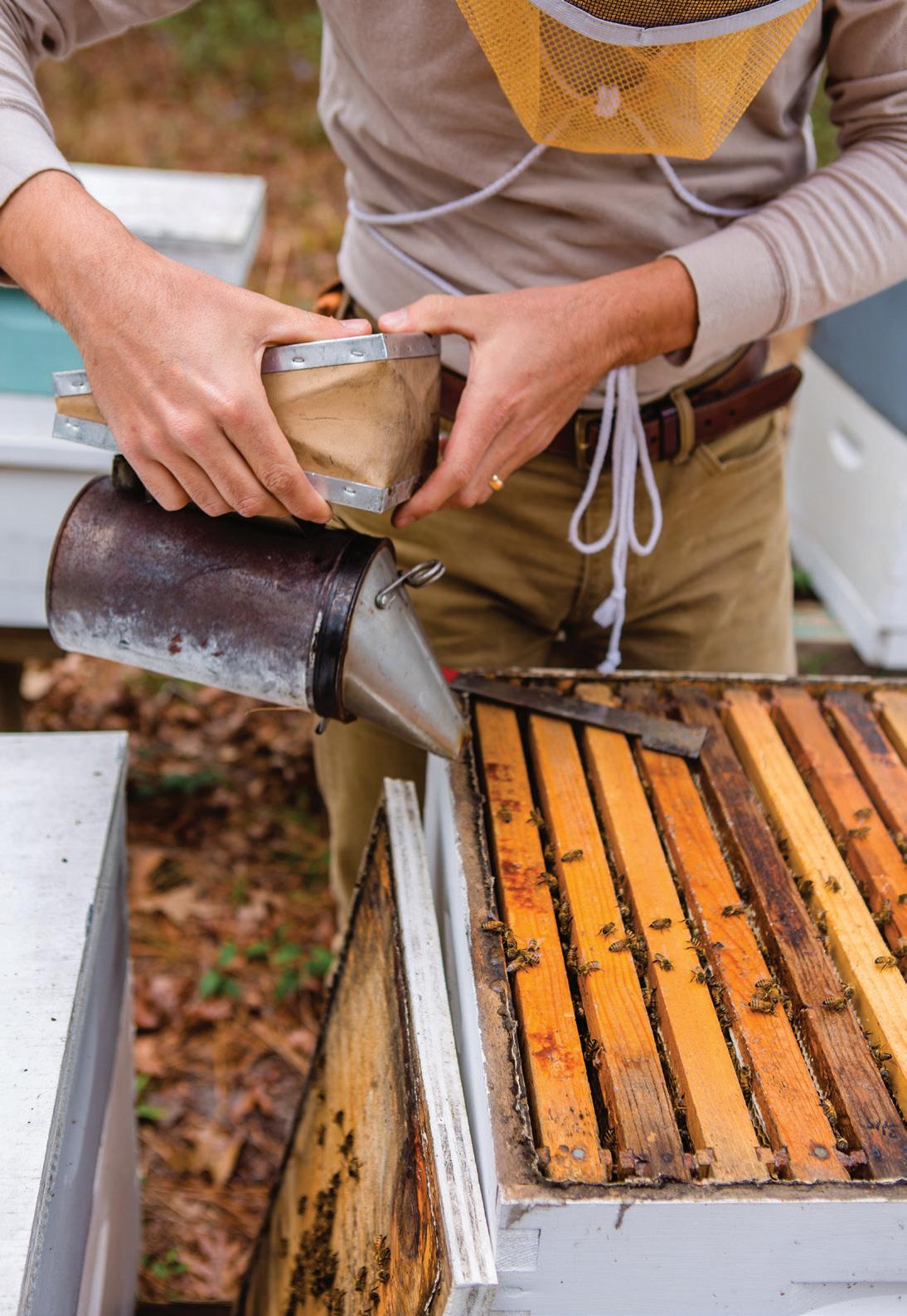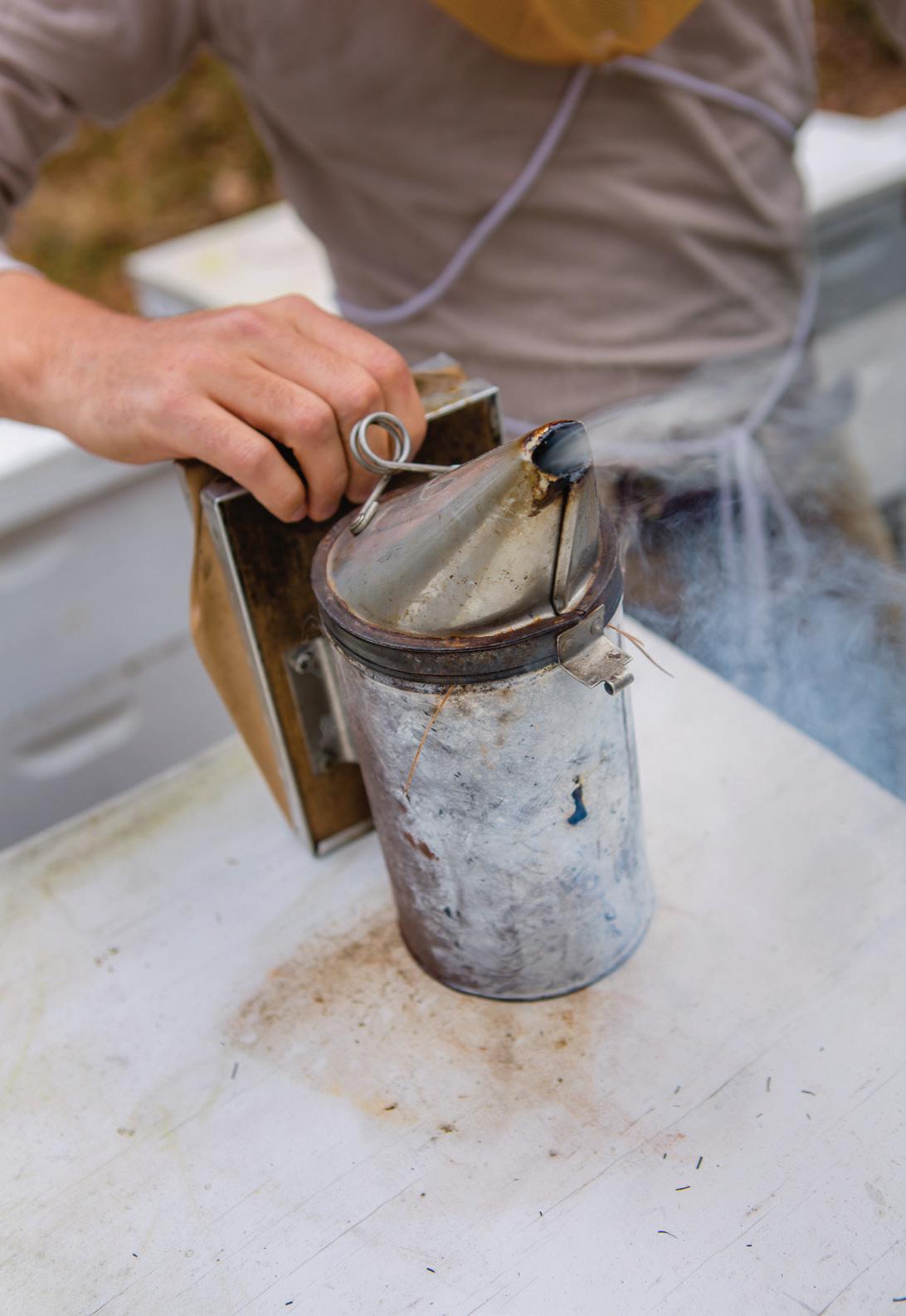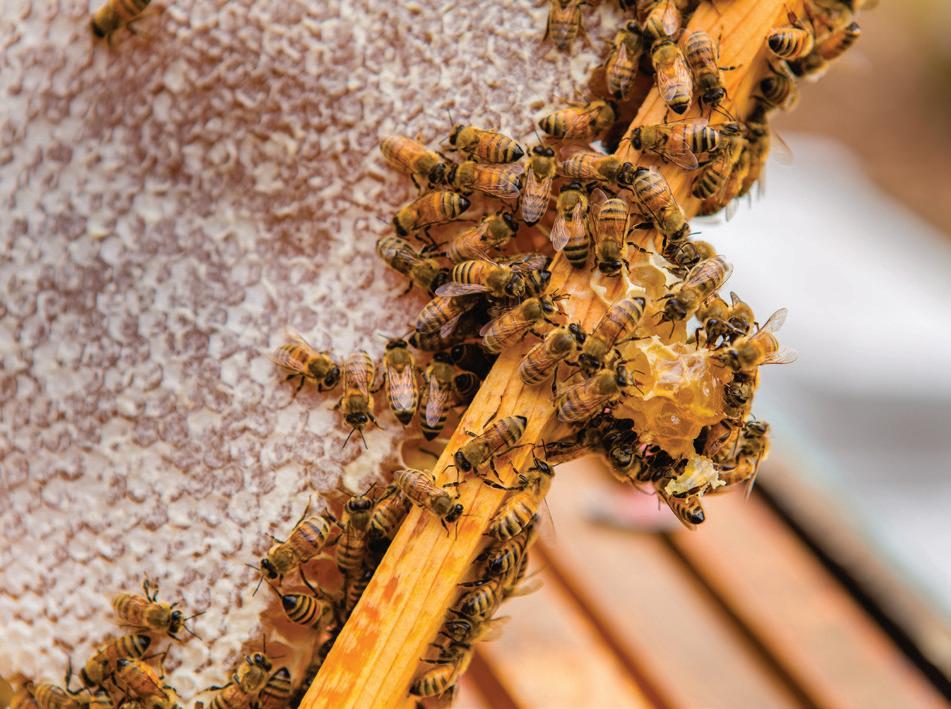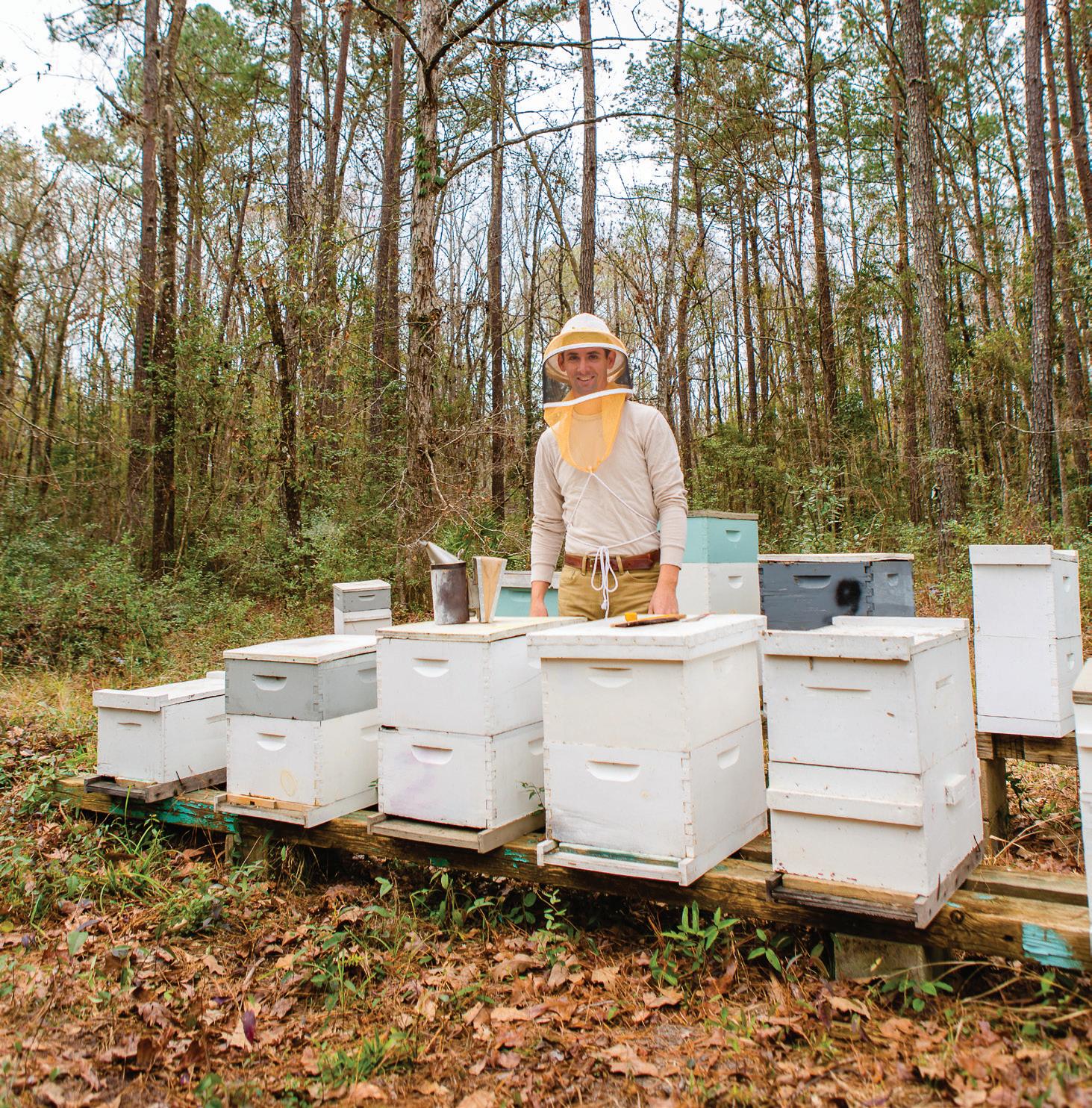






There’s a buzz along the coast — just ask local apiarist Eliot VanOtteren. Since opening Blackwater Bees three years ago, VanOtteren has been happy to find that beekeeping is really taking off in the Golden Isles. What started as a side hobby quickly took off for the professional photographer, who lives in Brunswick with his wife, Paula.
WORDS BY ALEX WESTBERRY PHOTOS BY CHRIS MONCUS3.00

“I wasn’t necessarily planning to start a business. There were just a handful of people who wanted to buy honey, but then a whole bunch more said they wanted to buy honey. So we just kept scaling up and getting a few more hives each year. Now I’m doing 20 to 25 hives and producing about 300 pounds of honey a year,” he says.
VanOtteren doesn’t just manage his own hives. He also looks after the bees at Frederica Golf Club, installs and manages other on-demand hives, educates the local community with visits to schools and churches, and is often on hand at local farmers markets to answer any questions from adults and kids while he sells his honey.
Beekeeping was a natural outlet for VanOtteren, who grew up loving the outdoors, gardening, camping, and hiking. You may even say he has it in his genes.
“My dad kept bees when he was in a college club and has always talked about it as a kind of romantic thing that he loved to do. About five years ago when he mentioned it again, said ‘Let’s do it!’ So,

What started with one hive each, now has blossomed to hives numbering in the twenties.
it’s been something that my dad and I got started on together, that we can do together, talk about together, and just work on together,” he says. What started with one hive each, now has blossomed to hives numbering in the twenties. VanOtteren’s dad and brother are even working together to open a meadery, which will produce wine made from honey.
But it’s not only about the business for beekeepers like VanOtteren. Hobbyists can also act as conservationists, incorporating sustainable beekeeping practices without the use of pesticides and monitoring colony activity of their hives.
Between 2015 and 2016, agricultural research groups estimate that the U.S. lost nearly half of its honeybee population due to Colony Collapse Disorder. The term covers a wide variety of conditions that



Busy as a Bee
Beehives are actually pretty simple. Hives are composed of two main parts. The deep hive bodies are the two bottom trays which essentially look like two boxes, one stacked on top of the other. In each body are 10 suspended frames of wax known as foundation. Here, the bees live and let live. The beekeeper doesn’t disturb these two bodies, since this is where bees store their own supply of pollen and honey along with the queen and the baby bees.
On top of the two deep hive bodies, the beekeeper usually lays a frame called a queen excluder. The excluder is simply a sheet that prevents the queen from wandering into the top section — because the top section is where the beekeeper gets his honey.
The top section mirrors the bottom. The top is composed of two shallow hive bodies that are stacked on top of the two deeper ones. These trays are a shallower version of those on the bottom, and this is where the bees will store their excess honey. Honey is typically harvested in the late summer.

negatively impact the health of the colony, such as pesticides, diseases, and parasites. Since bees, through pollination, are responsible for about one of every three meals we eat, the U.S. Department of Agriculture estimates that this recent loss equates to $30 billion of produce every year. With so much at stake, agricultural companies, small farms, and even local gardeners and hobbyists have taken up beekeeping.
In South Georgia, beekeepers aren’t immune to colony struggles. Kingsland farmer Bob Merck operates Merck Farms, originally an old rice and turpentine plantation located on the St. Marys River. Merck, who has an agricultural engineering degree from the University of Georgia, primarily uses the property to grow fruits and vegetables. But beekeeping intrigued him, and at one time, he was maintaining as many as 30 successful hives. After he sold bees to a blueberry farm in Brantley County, the hives mysteriously began to decline, ultimately leaving only a few hives to survive. Merck attributes part of this loss to competitors like yellow jackets and feral bees. But he isn’t one to give up and plans to use this experience as a lesson.
“I might have to buy more bees, but I’m going to try to catch some swarms, too. If I can find some feral bees in the woods on the property, I’ve heard of people having more success once you put them in a regular hive. I’m going to try a blend of both,” Merck says. “You can also plant cover crops like buckwheat, which are good for native pollinators. It just helps to try to maintain a healthy environment.”
VanOtteren can also attest to the success of once-feral bees as a resource for adding colonies, in addition to purchasing bees. “If they’re surviving in the wild, then that means they are able to survive on their own,” he says. “I’ve only ever bought one hive — my first hive.
Everything else has been swarms or splits (from former-feral colonies).”

If I can find some feral bees in the woods on the property, I’ve heard of peo ple having more success once you put them in a regular hive.
A large part of the success of this method can be attributed to feral bee removal, with which VanOtteren is happy to assist. During the spring, VanOttern receives weekly calls to help people remove bees from their property.
He also gets calls to do the opposite — helping with quick, start-up hives for the novice beekeeper. “It’s geared toward people who want to have some exposure to beekeeping but don’t want to dive headfirst into it. It turns into a mentorship, where set them up with bees at their house and they can either purchase the equipment from me or rent it. Then we arrange when will stop by and do an inspection, usually a couple times a month. can also help harvest their honey. There are a lot of different ways that we can make an arrangement, based on their interest,” says VanOtteren.
Bees are most active during the spring requiring about an hour a week to maintain two hives.



The general time commitment of beekeeping varies seasonally. Bees are most active during the spring, requiring about an hour a week to maintain two hives. Numerous local organizations are dedicated to the promotion and awareness of beekeeping. The Glynn County Farm Bureau has formed the Glynn County Beekeepers Association. Local beekeeper and Farm Bureau board member Susan Shipman says that the association receives requests for their programs throughout the year — from schools to scout troops and garden clubs. The beekeepers “explain not only the basics of keeping bees, but how to make soap, candles, and other products from beeswax. Our educational events often entail honey tasting, too, so people can appreciate the different flavors that characterize honey. [The flavor] is due to the different flowers the bees
are visiting,” says Shipman. Other events include Pollinator Week in June, National Honeybee Day in August, and CoastFest in October.
For those who want to help the bees but can’t commit to managing a hive, the easiest way is to promote their environment. Some counties use flags which residents put in their yards to indicate nospray zones or bee-friendly areas. Glynn County offers a mosquito control exclusion list, allowing residents to request to not have pesticides sprayed within their area. In addition to limiting pesticides, try to avoid mowing your lawn during the winter, since bees like to use grass as cover. Residents can also simply sprinkle wildflower seed on their property or plant native flowers in gardens to help sustain native bee populations.
Did You Know?
Bee boxes are typically painted white for two reasons. The paint protects the wood from the elements, and the white color reflects light, helping to keep the bees cool during the hot summer months.
GIM M/A 1/4
3.00 x 4.875
36660 GOLDEN ISLES MAGAZINE
GIM M/A 1/4
3.00 x 4.875 26696
ISLES MAGAZINE
6.00 x 4.875
36633